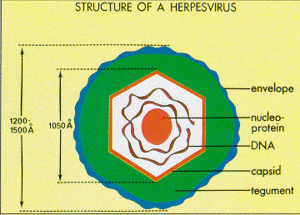Roseolovirus: Difference between revisions
| Line 21: | Line 21: | ||
Roseoloviruse HHV-6B can cause roseola infantum (aka Exanthema Subitum) in children under the age of three. Symptoms include a high-grade fever and a rash originating on the trunk. [[#References | [3]]] The severity of the fever can induce seizures. Treatment is often limited to fever-reducing medications like acetaminophen and ibuprofen as the rash and fever resolve in a few days. Sedatives may be administered to patients who are susceptible to seizures. [[#References | [5]]] | Roseoloviruse HHV-6B can cause roseola infantum (aka Exanthema Subitum) in children under the age of three. Symptoms include a high-grade fever and a rash originating on the trunk. [[#References | [3]]] The severity of the fever can induce seizures. Treatment is often limited to fever-reducing medications like acetaminophen and ibuprofen as the rash and fever resolve in a few days. Sedatives may be administered to patients who are susceptible to seizures. [[#References | [5]]] | ||
Because herpesviruses can integrate into the host's genome, reactivations can occur in immunocompromised hosts. These symptoms include rash, fever, seizures, encephalopathy, limbic encephalitis, amnesia, cognitive dysfunction, lymphadenopathy, colitis and hepatitis.[[#References | [4]]] | Because herpesviruses can integrate into the host's genome, reactivations can occur in immunocompromised hosts. These symptoms include rash, fever, seizures, encephalopathy, limbic encephalitis, amnesia, cognitive dysfunction, lymphadenopathy, colitis and hepatitis.[[#References | [4]]] | ||
==References== | ==References== | ||
Revision as of 23:09, 21 July 2013
Classification
Viruses; dsDNA viruses, no RNA stage; Herpesvirales; Herpesviridae; Betaherpesvirinae; Roseolovirus [Others may be used. Use NCBI link to find]
Roseolovirus 6A, 6B, 7
Description and Significance
Roseolovirus is a group 1 virus according to the Baltimore classification system. This distinction indicates double stranded viral DNA. Other viruses in Group 1 include the family Poxviridae which includes the smallpox virus, and other subfamilies within the Herpesviridae family like varicella-zoster virus that causes chickenpox. [1]
Roseoloviruses infect human hosts and can integrate into the host's genome where it enters a latent stage. Certain drugs have been shown to reactivate the virus. However, reactivations rarely occur in immunocompetent hosts. [2]
Give a brief description of the microorganism and explain why you think it is important. How does it relate to the other organisms in its phylum (bacteria and fungi) or group (archaea, virus, protist). Use the following for each reference in text (change number accordingly)--> [1]
Structure, Metabolism, and Life Cycle
Interesting features of its structure; how it gains energy (how it replicates, if virus); what important molecules it produces (if any), does it have an interesting life cycle?
Pathogenesis
Roseoloviruse HHV-6B can cause roseola infantum (aka Exanthema Subitum) in children under the age of three. Symptoms include a high-grade fever and a rash originating on the trunk. [3] The severity of the fever can induce seizures. Treatment is often limited to fever-reducing medications like acetaminophen and ibuprofen as the rash and fever resolve in a few days. Sedatives may be administered to patients who are susceptible to seizures. [5]
Because herpesviruses can integrate into the host's genome, reactivations can occur in immunocompromised hosts. These symptoms include rash, fever, seizures, encephalopathy, limbic encephalitis, amnesia, cognitive dysfunction, lymphadenopathy, colitis and hepatitis. [4]
References
[1] EXAMPLE ONLY. REPLACE WITH YOUR REFERENCES. Takai, K., Sugai, A., Itoh, T., and Horikoshi, K. 2000. "Palaeococcus ferrophilus gen. nov., sp. nov., a barophilic, hyperthermophilic archaeon from a deep-sea hydrothermal vent chimney". International Journal of Systematic and Evolutionary Microbiology. 50: 489-500. http://ijs.sgmjournals.org/cgi/reprint/50/2/489
[3] Exanthem Subitum. Reference.MD. 2012. http://www.reference.md/files/D005/mD005077.html
[4] Pellett PE, Ablashi DV, Ambros PF, et al. Chromosomally integrated human herpesvirus 6: questions and answers. Rev. Med. Virol. 2012; 22: 144-155. http://onlinelibrary.wiley.com.ezp1.lib.umn.edu/doi/10.1002/rmv.715/pdf
[5] Kohl, Steve. "Human Herpesvirus 6." in Nelson Textbook of Pediatrics, edited by Richard E. Behrman. Philadelphia: W.B. Saunders Co., 1996. http://medical-dictionary.thefreedictionary.com/Roseolovirus+infections
Author
Page authored by Morgan Schwoch, student of Mandy Brosnahan, Instructor at the University of Minnesota-Twin Cities, MICB 3301/3303: Biology of Microorganisms.

